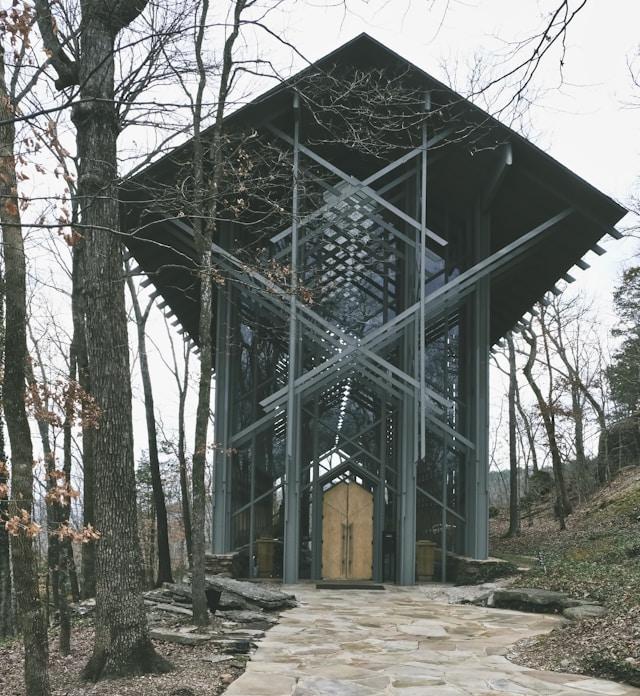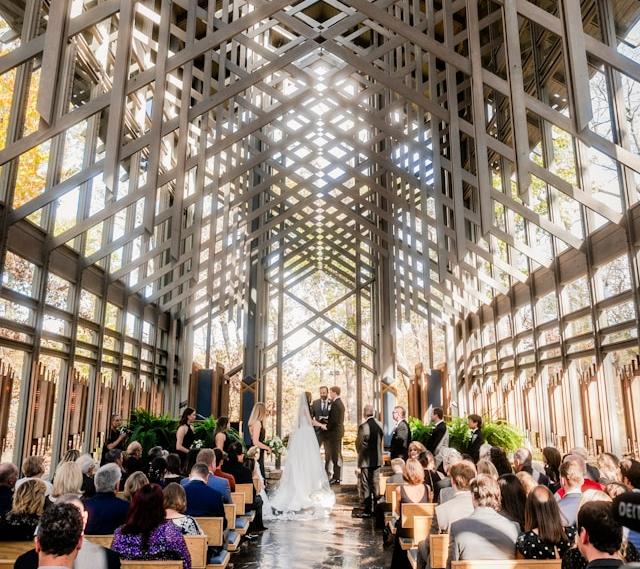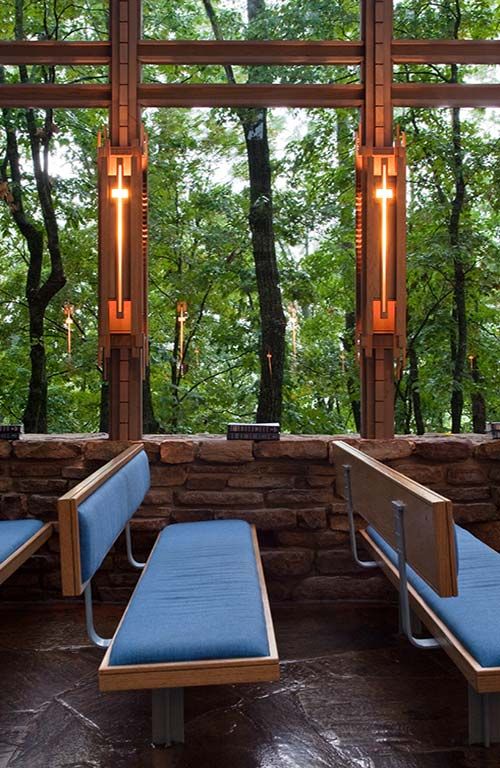
The Chapel
Thorncrown Chapel is a creative masterpiece uniting architecture with environment. Located just outside Eureka Springs in the rolling Ozark hills, the woodlands structure with free admission is a tourist favorite. In fact, over seven million people have visited since Thorncrown’s 1980 opening, and the site is a premier wedding location.
The narrow structure rises 48 feet towards the sky and extends 60 feet in length and 24 feet in width. The 425 windows looking out over the surrounding terrain make it a glass chapel. Inside Thorncrown are a colorful flagstone floor and fieldstone walls.

Outdoors Connection
The use of native materials makes the chapel appear a natural addition to the surrounding area. Specifically, only organic materials indigenous to northwestern Arkansas, such as flagstone and Southern pine, passed muster as materials for constructing Thorncrown.
The gray-stained pressure-treated pine used for the building matches the tree bark outside, and a skylight provides connection to the sky overhead. Also, the stone floor and walls blend perfectly with the structure’s rocky location. The result of these features is little distinction between inside the chapel and the environment surrounding it outside.
The design planning took care to preserve Thorncrown’s natural setting. No structural element was incorporated that was larger than what two men could carry through the woods.
The Architect
Architect E. Fay Jones, whom Frank Lloyd Wright mentored, designed this magnificent chapel. Jones drew inspiration for Thorncrown from touring Gothic chapels in Europe, particularly a light-filled one in Paris, Saint Chappelle. Accordingly, he dubbed his woodland chapel’s style as “Ozark Gothic”.
In addition to designing Thorncrown, Jones also came up with the chapel’s name. He considered it a combination of humility and glory, fitting for his creation’s description.
Unsurprisingly, Jones’ beautiful design has garnered numerous architectural awards such as the American Institute of Architect’s (“AIA”) Design Award of the Year for 1981. Another accolade is Thorncrown’s appearance at #4 on AIA’s top buildings of the 20th century list.
The Chapel Idea
The initial idea for a chapel in the Eureka Springs location came from Jim Reed, a retired schoolteacher. In 1971 he purchased 26 acres on which to build his retirement home. After returning from a walk on his property one day, Reed informed his wife they should build a glass chapel on their land.
But how would he make that dream a reality? Through a chance encounter at a local restaurant, Reed met a man who connected Reed with Jones and provided transportation for Reed to go meet the architect. During his career, Jones had always wanted to design a church or chapel, even doodling what such a structure might look like in the Ozarks. Reed’s property and Jones’ design were a match made in heaven, and Thorncrown Chapel came to life.

The Thin Place
The impact on visitors to the chapel is powerful, affecting believers and non-believers alike. Reactions range from tears to speechlessness. Many describe a feeling of peace.
The cause for these reactions? Architect C. Page Highfill characterizes Thorncrown as a thin place. Such a place is variously described as a location where heaven comes close to earth or a place where the sense of the sacred is more pronounced. So, the concept is that the line between heaven and earth is thin.
The phrase “thin place” comes from the ancient Celts and Celtic Christians. The Celts made the phrase popular and connected it to a specific location. Celtic Christians felt a deep connection to the natural world and viewed a thin place more in the context of the presence of the Divine. Celtic saints found a thin place where a location’s spiritual atmosphere allowed easy connection to God with little barrier between heaven and earth. Today the phrase’s meaning generally combines a location with a spiritual connection.
Experience It Yourself
Although a picture may be worth a thousand words, no picture or even a thousand words could do justice to the beauty of Thorncrown Chapel. Instead, the sight is one visitors must experience personally. They also need to experience the feeling of sitting inside a structure that looks like an arrow pointing heavenward and containing so many windows it feels the building is one with nature. Does the attraction offer a thin place with heaven? Only a visit to Thorncrown Chapel will answer that question for you. I did and would answer in the affirmative.


















